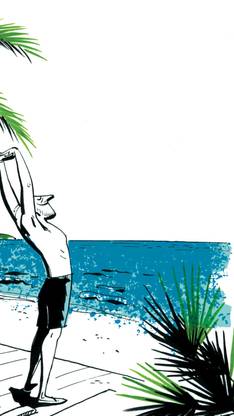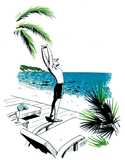Issue 25 / Global
Observation
What would win your heart – an alluring first impression or a tempting parting glance? For Tyler Brûlé it was the latter that had him dreaming of relocating the Monocle team to Berlin and bagging a summer retreat.

I used to think that first impressions counted for everything when you visited a city and that if you didn’t spy at least three or four cafés, nooks, shops and neighbourhoods worth exploring between your port of arrival and the check-in desk then it was unlikely you were ever going to have much of a meaningful relationship with a place.
On a recent trip to Berlin however, I found myself staring longingly out the aircraft window as we took off from Tegel and arced over the little cottages and gardens hugging the shores of the Tegeler See. Just minutes from the centre of the capital, the low-slung, boxy houses were warming themselves in the late spring sunshine and before the flaps were retracted I was already a lakeside resident in Berlin sitting in my garden on a Hans Coray chair, sipping a coffee, weighing up all the pluses of living in the northeast of the Bundesrepublik. In no particular order positives read like this:
— Outstanding value for money. In my German fantasy I’d have a large flat around Mitte and my small cottage on one of the lakes.
— Sound infrastructure from public transport to hospitals.
— Endless business opportunities with cheap office and retail rents.
— Endless diversions for dining and drinking.
— An easy-to-use airport in the form of Tegel.
— A new airport with global ambitions on the horizon in the form of Berlin-Brandenburg International.
— Frequent connections to sunny destinations with Air Berlin.
— High-speed rail links to the rest of Germany.
— A growing international community.
— Quick flying time to my house outside Stockholm.
— Excellent bookstores.
By the time the aircraft dropped out of the clouds on the approach to Heathrow, I’d practically moved all of Monocle’s operations to Berlin, had completely decorated the fantasy flat in Mitte and was thinking about how easy life would be if I could have lakeside living just 10 minutes away from my USM Haller-fitted offices. Then I hit Heathrow’s north runway with a rude thud.
Despite Berlin’s rather empty public purse, there’s an intoxicating sense that the city is quietly and confidently positioning itself to leap to the top of international liveability tables. Indeed, the city managed to be one of our biggest climbers in our 2009 index thanks to many of the things I listed in my fantasy lifestyle criteria above and also because the city has a knack for combining dependable German administration with a laissez-faire approach to planning.
Where the likes of London are overly concerned with zoning and making sure that everything and everyone has its place in the city, it’s Berlin’s randomness and lack of control that appeals. An airy, ground-floor apartment can be an office for an African NGO, then become a gallery, then morph into a men’s fashion store specialising in vintage sportswear and then find itself transformed into a restaurant with a Danish chef and Michelin star.
In the courtyards and along the side streets of the German capital, people are still drilling, tinkering, carving and sewing. Some have been doing it for decades while others are just getting the hang of how to use a digital Bernina to stitch together a pencil skirt. As Berlin makes way for bigger embassies, trade missions and corporate HQs, it’s this unique mix of creativity and light industry that must not be lost. As my colleague Andrew Tuck points out in his essay (page 66), it’s a lack of diversity in zoning that brings about some of the biggest problems for a community – or kills it altogether.
Berlin doesn’t have it all figured out – far from it. What it does show Asian, Australian, North American and even some European cities, however, is that you need to encourage a mix of residents, retailers, artists, mechanics and merchants that together generate a metabolism on the street. It’s no surprise that all of our top cities do this in some way but we think Berlin’s currently doing it best.
As this issue ships off to press we’re embarking on two special summer projects to keep you informed and entertained. From the end of June The Monocle Weekly will be going off air for the summer (back at the end of August) and we’ll be launching a new one-hour audio programme featuring live music from some of the world’s best acts mixed with contributions from Monocle’s editors and correspondents. Available to download on Friday afternoons (so you have something to listen to at the weekend), The Monocle Summer Series will run for the entire holiday season.
At the same time, our first Monocle on Med shop will be open in Palma, Mallorca, to cater to people who’ve parked themselves on the island for the summer or are passing by on their boat. Stocked with our full range of gear and a few exclusives, the store will also boast our first mini magazine kiosk of favourite titles. If you happen to be in and around the Iberian peninsula over the coming months then pop by for a glass of cava. The September edition of Monocle is out 20 August but if you want to hear from us in the meantime then drop me a note at tb@monocle.com. Happy summer!
For more from our editor-in-chief, read his column in the FT Weekend.


